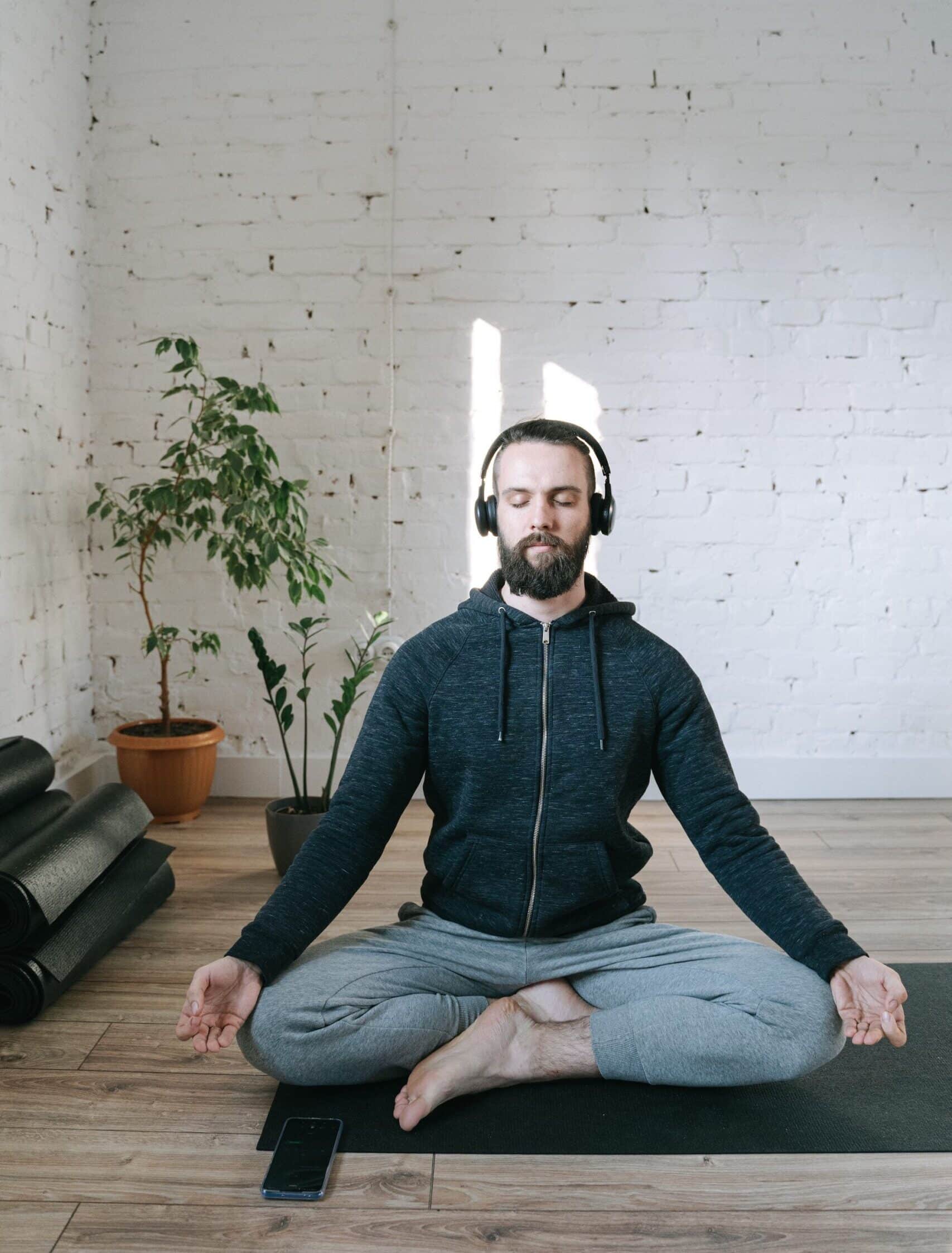How to Incorporate Guided vs Unguided Meditation Into Your Daily Routine
When we’re exploring different kinds of meditation or just starting our meditation journey, it’s common to search for guided meditations to create a certain feeling. Listening to a calm voice through visualizations and calming music can have a marked effect on our emotions, like listening to music or to an encouraging speech.
Guided meditation functions very differently from Vedic Meditation though, and it’s important to know what type of meditation you’re seeking when considering guided meditation vs unguided meditation.

Is guided meditation really meditation?
The word ‘meditation’ means to contemplate an idea. Guided meditation is a form of meditation, then, in a category of meditations called focused or concentrative techniques.
These kinds of meditation techniques require the mind to focus on a single thought or to direct the attention to a specific place. Guided meditation can feel very relaxing and soothing, and it’s important to realize that although we may feel more relaxed than we did before, we’ve still been concentrating on an idea for the whole session. Concentrating requires attention and energy, which means we won’t be providing a deep level of rest to the body.
Guided meditations can be a great way to take a break, to visualize things we aspire to or enjoy, and to immediately change feelings of anxiety or overwhelm. Guided meditations work by distracting our minds or reminding us of a positive, empowering idea. The guidance can be visual or auditory, timed or untimed, but if you’re paying attention to a sound or voice telling you what to think about, then it’s considered a guided meditation.
The outcome of guided meditation is not rest, then, even if a guided meditation for sleeping sends you off to sleep at night. Since the guided form requires concentration, it can distract your mind from certain thoughts or state.
After the guided meditation is over, though, your body will have the same level of embedded stress in the cells and underlying stress response patterns waiting to emerge. You will likely not have transcended thought altogether to immerse in the field of thoughtless pure Being, which is where many of the benefits of Vedic Meditation begin.
Concentrative vs auto-transcendent meditation
Concentrative forms of meditation include any that require you to focus on an idea to the exclusion of all others. So, any meditation techniques that require you to ‘not think’ fall into this category, as well as breathwork, guided meditations, mindfulness, and meditation styles where you focus on your body or breath.
These forms have their own benefits, such as increased focus, state changes, or building thought habits. You can build body awareness and greater awareness of your emotions by closing your eyes and focusing on them. Anything you focus on will grow in your awareness, so concentrative meditations can be helpful for learning or repeating thoughts that you’d like to stay top of mind.
When the mind is focused on one thing, however, the mind is too actively concentrating to allow the body to deeply rest. So, if we want the outcome of our meditations to be deep and profound rest or permanent stress release, we’ll need to consider auto-transcendent forms of meditation.
Auto-transcendence means that the technique used in meditation allows the mind to transcend thought without concentration. This means that thoughts are allowed, distraction is allowed, and there is no effort involved. Vedic Meditation is a form of auto-transcendence meditation, since the Bija mantra charms the mind effortlessly beyond thought and into a place of total stillness.

Start your Meditation Journey Today
ATTEND A FREE INTRO TALKMantras in guided vs unguided meditation
In Vedic Meditation, the mantra is a special meaningless sound that has been passed from teacher to student across the tradition. Each meditator receives their own unique sound to best match their age and stage of life, and they do not share their mantra once they have received it.
The mantra floats in and out of their awareness as they meditate, alongside their thoughts. Vedic Meditators do not resist or try to control thoughts at all, we simply allow them. Sometimes we forget the mantra altogether and think about mundane parts of life for a while, and then the mantra will quietly arise in our awareness again.
Since the mantra is a special sound designed to charm the mind, and since the meditator can effortlessly allow it to come up in their mind, it has a special effect on our thoughts over time. Our mind naturally wants to follow the mantra and our thoughts naturally become quieter and quieter. Eventually, the mantra brings our awareness beyond thought to the source of thought: pure being.
You may encounter a mantra in both guided and unguided meditation, but they work differently in each. In a guided meditation, the speaker may say a mantra over and over again, but the meditator concentrates on listening rather than allowing thoughts to bubble up effortlessly. The external stimuli cause the mind to respond with attention, and the listening does not result in transcending thought altogether. It has a different result, which is whatever the guided track directs the meditator to consider.

Rest in unguided meditation
The unique ability of the Bija mantra to charm our minds beyond thought and into transcendence brings the unique benefit of auto-transcendence meditations: deep rest. The body is able to rest even more deeply than sleep inside these forms of meditation, and the deep rest allows the body to easily release stress in the form of thoughts.
That is why we allow thoughts in Vedic Meditation: to avoid concentration and prevent rest and also to allow the stress to leave our bodies through the energy impulses that are thought forms.
In this way, we can begin to take our thinking mind from greater states of activity into what we call our least excited state, into that quiet inner still awareness called the field of Being where the mind and the body rest so deeply. This kind of rest allows us to be nourished from the inside out and to naturally feel more rested and calm in our waking states.
In Vedic Meditation, we practice for 20 minutes twice a day. After that, we can feel free to do any other types of meditations and receive even greater benefits from them.
Combining meditation types
If your goal in your meditation practice is to experience rest and increase your stress resilience, then auto-transcendent forms of meditation will be important for you to integrate into your daily habits (with the instruction of a qualified teacher).
Most Vedic Meditators notice that when they feel less stressed, they get more out of their other meditation or mindfulness practices than they did before. Over time though, many will drop other forms of meditation or mindfulness practices because they notice that their Vedic practice provides them with all of the rest and calm they were looking for.
We say that no other practice can harm Vedic Meditation, so long as they are not combined with Vedic Meditation. Vedic Meditation works only if it is practiced on its own. Then the meditator can practice any other forms they like.
Are guided meditations better for short sessions?
Vedic Meditation sittings are twenty minutes long, and based on students’ experience and research on the brain, we say that meditations 5 minutes long or less are not really doing anything for you. If you only have 10 minutes and you want to go to sleep, a guided meditation may suit you at that time.
One other thing to consider about guided meditation is that the person who is guiding you could have any level of experience or mastery of meditation themselves. With Vedic Meditation, your teacher will only be one who has trained for 12 weeks in India with masters like Thom Knoles and the pre-eminent maharishis and gurus of the Vedic tradition.
The Vedas have been around for 5,000 years, and the mantras we use and techniques we implement come from a lineage of masters. Each teacher has not only learned how to meditate, but they’ve learned how consciousness works and how stress enters and leaves the body. They’ve learned hundreds of mantras to assign the right one to each student, and they have personally practiced thousands of hours of meditation.
Any Vedic Meditation teacher who offers to assign a mantra through a Zoom call, who offers a guided meditation you can listen to, or who does not teach the Learn to Meditate course is not guaranteed to have the level of mastery and training that qualified Vedic Meditation instructors have.
All that to say, are guided meditations effective for listening to something calming for a short break? They can be. They are not effective tools to deeply and consistently release stress from the body or rely on a practice that is based on thousands of years of tradition and proven effectiveness.
Learn to Meditate
To receive your own Vedic Meditation mantra and start a twice daily practice, schedule an intro talk with me, or sign up for my next Learn to Meditate Course in Los Angeles or New York. You won’t have to stop enjoying guided meditations or any other wellness or spiritual practices, instead, you can enhance them by releasing stress and bringing greater presence to each practice after your Vedic Meditation sessions.






